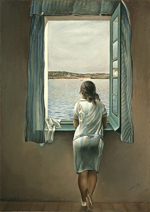
"A View of the Woods"
"Though there was seventy years' difference in their ages, the spiritual
distance between them was slight" (526).
Flannery O'Connor's "A View of the Woods" (1956; 1957)
Points
for Reflection
Flannery O'Connor's "A View of the Woods" (1956; 1957), 525-46
- which character's perspective shapes most of the narrative? Given this bias, to what degree can we accept at face value the character descriptions/analyses contained in the tale?
- why does Mr. Fortune ("the old man") prevent his daughter and her family from paying rent on the land of his that they farm?
- how does Mr. Fortune define "progress"?
- in what ways does Mary Pitts resemble the grandfather who calls her "Mary Fortune"?
- Mr. Pitts lashes his daughter, Mary, around the ankles with a belt intermittently "for no reason" (530). Does the tale gradually provide an explanation for this apparently unprovoked punishment?
- Mary provides three reasons for why she dislikes the idea of her grandfather's selling the lawn in front of the house (531-32). Which is the most important?
- what Biblical principles do Mary and her grandfather cast at each other when angry (532)?
- in what one way does Mary presumably not resemble her grandfather?
- does the tale, as a whole, substantiate the old man's assertion that Mary's failure to "stand up to" her father when he beats her is simply a flaw in her character, an "ugly mystery" (536)?
- why might Pitts have not whipped Mary after picking her up from Tilman's (536-37)?
- what does the old man see the first two times he looks out at the woods from his house in an attempt to understand Mary's perspective (538)? What does he see the third time, and what symbolic and/or spiritual import might it carry (538)?
- how does the old man abuse the notion that "All men were created free and equal" (539)?
- does the old man's affection for Mary ever register as true, unselfish kindness?
- at a critical moment, the old man loudly declares that he is no Pitts, unlike Mary, but "'PURE Fortune'" (541). Consider his use of money for a moment--what does he do with his own, ever-growing fortune?
- is the old man's "heart condition" (534) merely physical in nature?
- Mr. Fortune, once convinced that all the Pitts kids except Mary should be whipped once a week on principle (529), later decides that Mary too needs a whipping. What changes his mind?
- why do you think Mary proves less than obsequious when her grandfather pulls over to whip her (544)? What distinguishes this situation from all the times her father has whipped her?
- what does Mary do or say which hurts her grandfather most?
- following the old man's irrevocable actions (545), he sees two separate visions while lying on the ground (545-46, 546). Do they prompt change in the old man, or not?
- what do you imagine will happen immediately following the events related by this story?

A Figure at the Window (1925)
oil on canvas
Salvador Dalí
Dr. Paul Marchbanks
pmarchba@calpoly.edu
![]()
